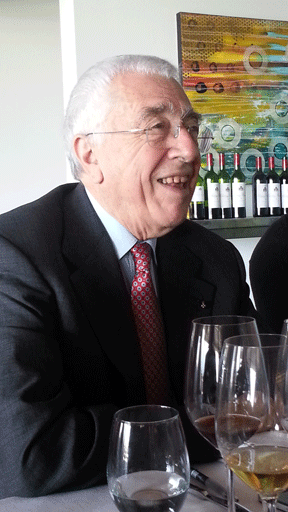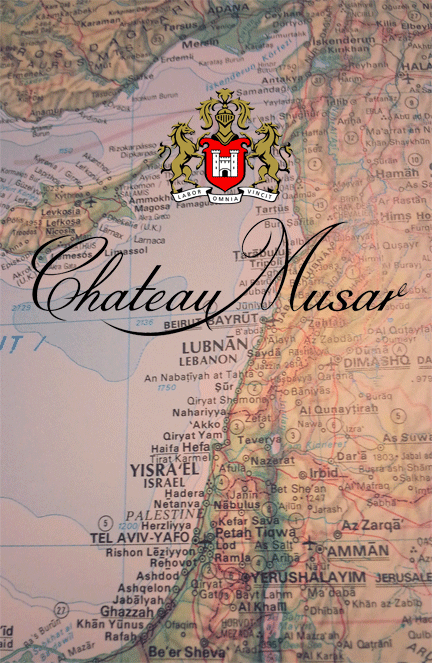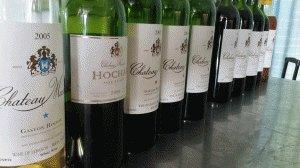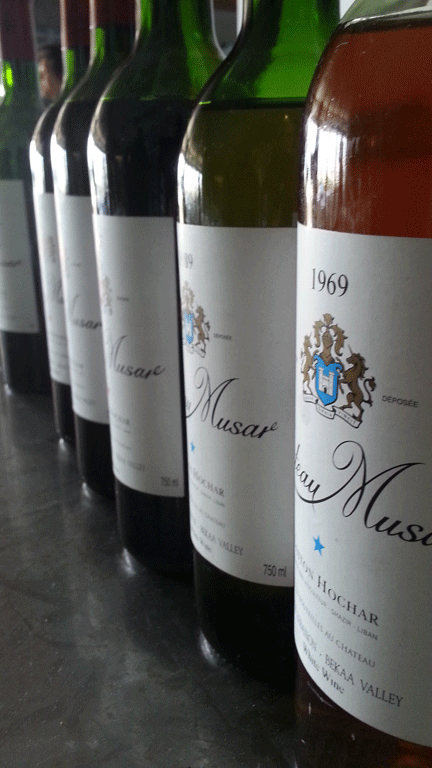Finally, Good News From the Middle East
Since I was a kid, I turn the TV on and hear only bad news about the Middle East. War, terrorism, extremists, blood for oil, puppet governments and genocide were just a few of the nightly news stories. It seems as though nothing is improving, only getting worse. So you can see why it was a delight when I sat with Serge Hochar and his son, Marc and tasted the wines of Chateau Musar from Lebanon.
A few weeks ago I had the pleasure of meeting this father and son wine making team along with several other of my San Diego wine buddies. I must say thank you to John Erickson from Jaynes Gastro Pub for giving me the title to this post. John said this while sitting across from me during the tasting. If you have never heard of Chateau Musar, then you are probably re-reading the title over and over. “How could this be the title of a wine blog post”? It is foolish to think that the cradle of civilization does not make wine. We think of the Middle East as being a dry arid desert climate, so how could they produce wine there. Have you ever been to Washington State? Have you ever been to the Elqui Valley in Chile? Both hot dry desert climates and both produce high quality wines. If the human race had its beginnings in this region, and wine has been produced for over 8,000 years, then Lebanon is a region as good as any to produce wine. The Bekaa Valley is the growing region from which the Hochars harvest their grapes. But what is more important than where they harvest their grapes, is how they make their wine. There are many other producers in Lebanon making wine; however, no one is making it like the Hochars.

Serge Hochar
A while ago I was talking with a sommelier friend of mine, Julian Mayor from Bourbon Steak in D.C.. He told me that he had to go to Lebanon for a wedding. Being the wine geek that he is, he paid a visit to Chateau Musar. Julian was in Somm paradise. However, while talking with other people in the region about Musar, they dismissed the winery as being a winery “stuck in the old ways”. “Stuck in the old ways”? Yeah, they are correct. What I learned from my visit with Serge and Marc, is that they are damn proud of it and so are all the sommeliers that come across these wines.
Chateau Musar began in 1930 by Serge’s father Gaston Hochar. Serge and his brother Ronald took over the winery in 1959. Their approach has always been a hands off approach. They believe that wine should be made in a non-interventionist way without technology to aid them. The Chateau Musar wines are blends. The red wines are made from Cabernet Sauvignon, Cinzault, Carignan, Grenache and Mourvedre. The grapes are harvested separately and fermented in concrete tanks separately. It is racked and put in vats for 6 months. Then transferred to un-toasted barrels for 3-4 years. It goes back into vats for another year. After the second year in vat blended and returned to concrete for another year. At the end of the 3rd year finally bottled. The wine is never released before 7 years of aging. Serge only releases the wine when he knows the wine will get better. For example, the 1974 release date was 1981; however, Serge felt that the wine was not ready. The ’74 was finally released in 2004. The Hochars say that they release the wine when they know it will get better, grow bigger and younger.
How in the world can a wine get younger with age? It sounds like Benjamin Button. But it is true. We tasted the ’05, ’04, ’00, ’01, ’98 & ’93 reds. The 2005 and 2004 had that Brett funk, band-aid and oxidized character. This is something that I would expect when I taste a wine with 9-10 years of age. But as we moved to the “98 and ’93 the wines became fruitier, lusher, the Brett funk gave way to leather, prunes and cherries. It was so strange. It was like the ’04 & ’05 were in this awkward teenager stage and the ’93 was just starting to reach that comfortable manhood we men reach at the age of 30-40 years old. The wines became more refined and elegant.
Musar breaks all the rules and stereotypes. White wines are not supposed to age. I have had some amazing older Rieslings, Chenin Blancs and White Burgundies; but in general, white wines should be drunk young. Not the Musar blancs. We tasted the Musar Blanc ’89 and found it to still be oxidized but with life and longevity. If I would have tasted it with a blindfold at room temperature, I would have easily confused it for a red wine. It had tannins. We then tasted a white 20 years older, the ’69 Musar Blanc. The wine was earthy, oxidized, but youthful. How in the hell can that be? I just said youthful for a 45-year-old wine. I guess if I put it in human terms, 45 years old is still young. I believeSerge and Marc make their wines so taht they can be enjoyed throughout their lifetime. Maybe even out live them. When they do release the wines, they only release half and keep the rest in cellar to re-visit later in life. The idea is that wine is a living organism. The hands off approach allows the wine to grow up, learn, experience and create its own character. If the wine is left in the right conditions, made naturally there is no limit to its life. Like a human. Nurture that human being from infancy on, but don’t stifle it, don’t feed it poison and see how long he lives.
Serge says, “My no touch philosophy allows my wine to live longer than it should”.
Wine is just like a human, unpredictable. One day it tastes amazingly, the next day horrible. Where you are, what you are doing affects the way we perceive wine. Sometimes the wine closes up. Leave a bad wine open a few days and go back to it and you might be surprised. A wine produced in this hands off approach has a chance of changing everyday. One day it is awful the next suburb. Wines made in the wine room with all hands on deck have been so manipulated that they don’t have a breath of their own. Their life stunted, so much so that they can no longer age. The wine maker has added tartaric acid, purple dye, added sugar and added chemicals so that when we drink the wine it tastes a certain way. The wine does not have a voice of its own, but groomed and trained to be one thing, enjoyed by 1 palate for a short time. These are the George Orwell “1984” wines. The Bob Geldof “Another Brick in the Wall” wines. Marching off the bottling line into wooden boxes and off to the store front and sold for hundreds of dollars. They are big, masculine, robust and arrogant wines. We drink them young and the we say, “Wow, what power!” Kind of like looking at the high school star quarterback. In his senior year he is at the top of his game. When he enters college he might continue his career. However, he doesn’t make the pros and as life takes its toll, the glory days disappear. Ten years later, he is 32 and working an office job , loosing his hair and has gotten himself a nice beer belly. Those manipulated wines are the same, 10 years down the road they become awkward and underwhelming.
Marc Hochar told us that the next time we are at a wine party and everything is winding down, go around and smell the empty glasses. You will be surprised to see what you smell. The wines that are made naturally will smell like wine, like the wine that was in the glass. The wines which have been manipulated will not smell like wine, but all the junk they put into them. Try it one day, you might stop drinking certain wines.
So the next time that you turn on the TV, don’t get discouraged by what your hear about the Middle East. There is some good coming out from there. Instead, go out and look for a bottle of Chateau Musar.
If interested in any of the Chateau Musar wines and you’re in San Diego, join Prime Cru Wine Club, fill out the form and in the comment section let me know and I will be able to give you a list of what I have. I believe I still have a few bottles of the ’93 rouge available.












